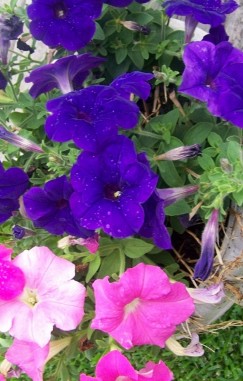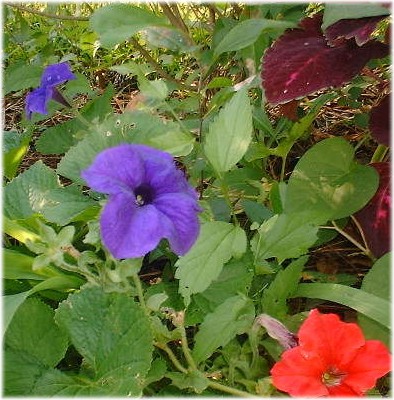| Gardens Ablaze | ||
|
|
Petunias
|
|
|
Detailed Annual Site Map
Home
|
Available in every color but orange, sun-loving Petunas are long-lasting, colorful, pest-tolerant, and easy to grow, enhancing any home gardening situation that can sustain the 6 hours minimum a day of direct sunlight required by all members of this plant family. All Petunias have a sprawling, low growth habit, and thus lend themselves well to containers, window boxes, borders, and mass plantings, requiring only minimal care to produce blooms for virtually the entire season. Before the hybridizers discovered them, all Petunias in their natural form bore pink flowers. Indeed, the most robust and least problematic Petunias to this day sport the color pink, with red being the weakest and most troublesome. All the other colors come in between, but all (including the reds) will still do satisfactorily if their basic care and watering requirements are met. Petunias can also be fragrant, with purple, pink, and white being generally the best choices as far as fragrance is concerned. In most cases, this fragrance is more pronounced at night.
Petunias are one of the edible flowers and I have heard that you can use the flowers as wraps for various finger snacks and such, much like squash flowers. However, I have tasted both the blooms and the petals and personally, I think they taste a bit grassy to be of much use in the kitchen. Petunias can add color to cut flower arrangements, but they do tend to droop, and they don't last as long as many other cut flowers, making them a borderline choice for the cutting garden. If you want their bright color in arrangements, however, they can be strengthened by attaching the stems to florist's wire. Problems with Petunias are few, and I hear more complaints about lack of flowering than anything else. This is one plant that demands at least 6 hours of sun per day, and though it will survive, it will bloom poorly or not at all with too much shade. It will also not tolerate a poorly drained soil, so do prepare your soil thoroughly before planting to sidestep potential problems. As annuals, Petunias die off at the first, frost. However, a few of the newer varieties, including the award-winning "Wave" series are remarkably frost tolerant and may even make it through to the next season if in a sheltered position in zone 7 or up. All in all, Petunias pack about the most color you can get for the buck in the home landscaping world. If you haven't really given them a try, do so this year. If you give them what they want, you won't be disappointed!
Custom Search
|
|
|
Gardens Ablaze |
||
 Most
of us have planted a lonely Petunia in a pot at some point in the past, but too
few of us have fully discovered the impact that these versatile plants can have
on our home landscapes.
Most
of us have planted a lonely Petunia in a pot at some point in the past, but too
few of us have fully discovered the impact that these versatile plants can have
on our home landscapes.  Petunias can be started from seed 6-10 weeks
before the last frost, bought in flats at the garden store, or propagated by
stem cuttings. If planting
store-bought plants, disturb the roots a bit without twisting or bending the
main stem to encourage root spread once the plant is in the ground. When
taking cuttings, cut a stem a few inches long just below the leaf node and place
in moist soil in a shady place. It takes a couple of weeks for the cutting
to start putting out roots.
Petunias can be started from seed 6-10 weeks
before the last frost, bought in flats at the garden store, or propagated by
stem cuttings. If planting
store-bought plants, disturb the roots a bit without twisting or bending the
main stem to encourage root spread once the plant is in the ground. When
taking cuttings, cut a stem a few inches long just below the leaf node and place
in moist soil in a shady place. It takes a couple of weeks for the cutting
to start putting out roots.